A dual band circular monopole antenna for Bluetooth and Ultra wideband applications with WiMAX notched band is presented. The antenna shows return loss characteristics less than -10dB for Bluetooth (2.40-2.47 GHz) and Ultra wideband (2.73-11.5 GHz) except at notched band. High VSWR is obtained at 2.6 GHz and WiMAX band (centre frequency 3.5 GHz) .The radiation patterns show omni directional characteristics at lower frequencies with good polarisation isolation.
Keywords |
| Ultra wideband, Bluetooth, return loss, group delay |
INTRODUCTION |
| In 2002, FCC has allowed the unlicensed use of ultra wideband spectrum (3.1GHz-10.6GHZ) with restricted power
emission of -41dBm/MHz under part 15 rules [1]. The ultra wideband technology offer many advantages like high data
rate at short ranges, low power, noise immunity, relatively simple receiver architecture. This has led to huge research in
Ultra wideband (UWB). Bluetooth is another technology existing in globally accepted unlicensed Industrial, scientific,
medical(ISM) band for low power short range communication. Integrating Bluetooth and UWB in a single antenna
provides compatibility between 3G and 4G technologies in the area of wireless personnel area networking. Wireless
technologies like Bluetooth and UWB has applications in body area networks since they have long battery life and have
low power emissions. Performance of UWB in terms of data rate is very high compared to Bluetooth in short
ranges<10m.At Ranges greater than 10m Bluetooth provides better data rate than UWB. These technologies also differ
in the modulation schemes used and application profiles. Dual band Bluetooth and UWB antenna thus provides
scalability in all the parameters mentioned above. But when UWB is developed the coexistence with other wireless
technology like WiMAX has to be considered. So in order to avoid the interference notches has to be added in the
UWB band. |
| Lately monopole antennas of various shapes having ultra wide bandwidth have been reported [2-5]. Several
antennas were designed for ultra wideband having notched bands for interfering bands like WLAN and WiMAX [6, 7].
Single band antenna integrating Bluetooth and UWB with large impedance bandwidth has come up [8]. Usual methods
of band notching do not work for integrated Bluetooth and UWB antennas since Bluetooth band is very narrow.
Conventional methods for dual band antenna design are by reactive loading with λ/4 stub [9],λ/4 strip monopole [10]
and slots [11] in FR4 substrate. |
| In this paper a dual band Bluetooth and UWB antenna using offset ring slot in polytetrafluoroethylene (PTFE)
substrate is presented. PTFE substrate commonly known as Teflon is characterized by low dielectric constant εr =2.1
and low loss tangent, tanδ=0.0004.The substrate is characterized by hydrophobic nature, high non reactivity, high
melting point about 621°F. |
ANTENNA DESIGN |
| Comparing different monopole antennas circular monopole antenna provides largest bandwidth. The lower edge
frequency, ‘fl’ in GHz, corresponding to VSWR<2 for planar circular monopole is given by [12] |
 |
| Where ‘r’ is the radius of patch and ‘g’ is the gap between ground and radiating patch in centimeters. A small
correction factor occurs in this formula due to the substrate. The wide bandwidth of UWB is obtained by modifying the
ground.The width of 50 Ohm microstrip line is calculated at 2.4 GHz. Circular slot inside the monopole does not affect
the bandwidth of monopole. The dual band nature is obtained by embedding another smaller circular monopole inside
the slot. The notching of WiMAX band is obtained using a folded slot in the upper half of the radiating patch. |
| The initial dimensions of inner monopole and outer monopole is calculated from (1) for frequency corresponding to
lower edge frequency 3.1GHz of UWB and 2.4GHz of Bluetooth respectively. The gap between the inner monopole
and ground plane is kept high so that it has smaller bandwidth. Various parameters like slot width affect the frequency
ratio of two resonances. The angle of the slot affects the impedance matching of lower resonant frequency. Two
symmetrical strips are added to the lower edge of inner circular monopole for tuning of lower band frequency. The
length of folded slot is initially designed for quarter wavelength corresponding to notched frequency. The notch
frequency ‘f’ is given byc |
 |
 |
| Where ‘L’ is the total length of slot. The antenna is simulated in Ansoft HFSS 14.0. The size of antenna is
32mm*45mm*1mm. The optimized dimensions are R1=6.5mm, R2=12.8mm, R3=9.5mm, L=45mm, W=3.3mm,
Lg=12mm, Wg=23.5mm, L1=13mm, W2=2mm, W1=2 mm, L2=4mm, Wg=23.5mm, S1=.10mm, S2=2.2mm,
S3=4.3mm |
RESULTS AND ANALYSIS |
| A. Return Loss |
| The simulated return loss of antenna as shown in Fig 2. The antenna shows impedance bandwidth characterized by
return loss less than -10dB for Bluetooth is from 2.4GHz-2.47GHz and that of UWB is from 2.73 GHz-11.5 GHz. The
WiMAX notched band is characterised by return loss greater than -10 dB from 3.3 GHz-3.6 GHz. |
| B. VSWR |
| Fig. 3 shows the simulated VSWR of the antenna .The VSWR is less than 2 over Bluetooth (2.4GHz-2.53GHz) and
UWB (2.82-10.6GHz) expect at WiMAX notched band. VSWR at 2.6 GHz is about 60 and 3.5 GHz is about 16. This
indicates good rejection of band between Bluetooth and UWB (2.47GHz- 2.73GHz) and WiMAX (centre frequency 3.5
GHz) is obtained. |
| C. Surface Current Distribution |
| Surface current distribution at notch frequency 3.5 GHz is shown in Fig. 4. The upper end of folded slot has high
current distribution at 3.5 GHz confirming the quarter wavelength resonator behavior of slot. |
| D. Radiation Patterns |
| E plane and H plane radiation patterns at 2.46 GHz, 3.1 GHz, 5.6 GHz, and 7 GHz are shown in Fig. 5. At low
frequencies the H-plane patterns are circular while the E-plane patterns show a bilobial nature implying
omnidirectional radiation patterns of typical monopole. At low frequencies cross polarization component is poor
implying reduced interference. At high frequencies the patterns become more distorted with increased cross polarized
component |
CONCLUSION |
| A Bluetooth (2.4 GHz-2.47 GHz) and UWB (2.73 GHz-11.5 GHz) antenna with notched WiMAX band (centre
frequency 3.5 GHz) has been simulated. Good rejection of notched bands is achieved. The radiation pattern is
omnidirectional with reduced cross polarised component at low frequencies. Further work has to be done to obtain a
stable radiation pattern throughout UWB band. Time domain analysis can be performed to investigate time domain
characteristics of Ultra wideband. |
ACKNOWLEDGMENT |
| We would like to thank the department of ECE, RIT, Kottayam for providing us with facilities for
accomplishing this work |
Figures at a glance |
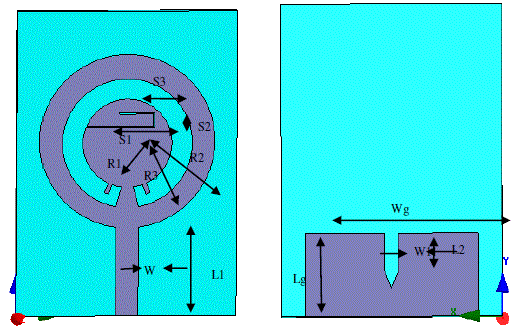 |
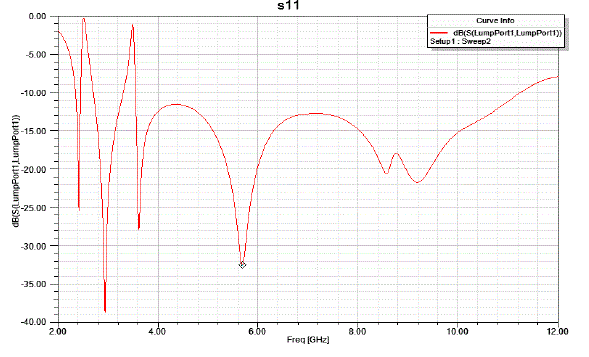 |
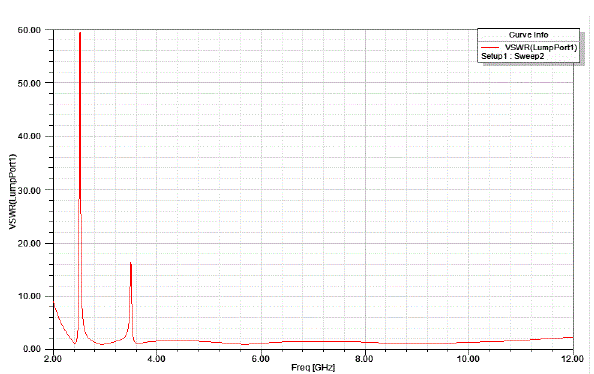 |
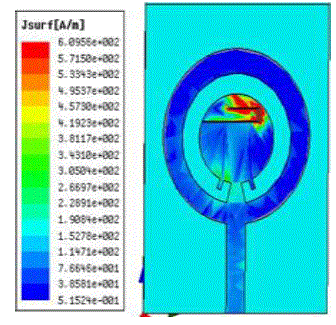 |
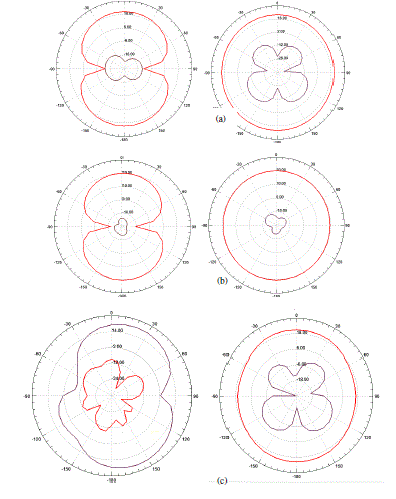 |
| Figure 1 |
Figure 2 |
Figure 3 |
Figure 4 |
Figure 5a |
|
References |
- B GrzegorzAdamiuk, Thomas Zwick, and Werner Wiesbeck, “UWB Antennas for Communication Systems” Proceedings of the IEEE, Vol.100, No. 7, pp. 2310-2321, July 2012
- Agarwall, K.P.Ray, and G. kumar, “Wideband planar monopole antennas” IEEE Transactions on Antennas and propagation, vol. 46, No. 1,pp.294–295, 1998
- ZuosheingXie, et .al, “Ultra wideband implementation of printed rectangular monopole antenna ” IEEE International Conference onComputer Science and Automation Engineering (CSAE), vol. 1, pp. 300–303, 2011
- Weng, Y.F.Cheung , Yuk, “Effects of ground-plane size on planar UWB monopole antenna” IEEE TENCON Conference, pp.422–425, 2010
- Jianxin Liang, Choo C. Chiau, Xiaodong Chen and Clive G. Parini, “Study of a Printed Circular Disc Monopole Antenna for UWB Systems.”IEEE Transactions on Antennas and Propagation, Vol. 53, No. 11, November 2005.
- Wen Jiang , WenquanChe, “A Novel UWB Antenna With Dual Notched Bands for WiMAX and WLAN Applications”, IEEE Antennas andWireless Propagation Letters, pp.293–296, 2012
- Chong Yu Hong and Ching Wei Ling, “Design of a Planar Ultra wideband Antenna With a New Band-Notch Structure”, IEEE Transactionson Antennas and Propagation, Vol. 55 ,No. 12, pp 3391-3397,Dec. 2007
- Malheiros-Silveira, G.N. Hernandez-Figueroa, Oshioka, R.T. “Novel monopole antenna for Bluetooth and UWB applications” IEEE Antennasand Propagation Society International Symposium (APSURSI) , pp.1–2,2012
- Yildirim, B.S., Cetiner, B.A., Roqueta, G., Jofre, L., “Integrated Bluetooth and UWB Antenna” IEEE Antennas and Wireless PropagationLetters, Vol. 8, pp.149–152, 2009
- Mishra, S.K., Gupta, R.K., Vaidya, A. , Mukherjee, “ Compact Dual-Band Fork-Shaped Monopole Antenna for Bluetooth and UWBApplications”, IEEE Antennas and Wireless Propagation Letters, vol.10, pp.627 –630, 2011
- Kaizhong Zhan, Qinggong Quo, Kama Huang, “A novel kind of Bluetooth and UWB antenna”, IEEE conference on Microwave andMillimeter Wave Technology (ICMMT),pp. 1038 - 1041,2010
- G. Kumar and K P Ray, “Broadband Microstrip Antennas”, Norwood, Artech House, 2003
|